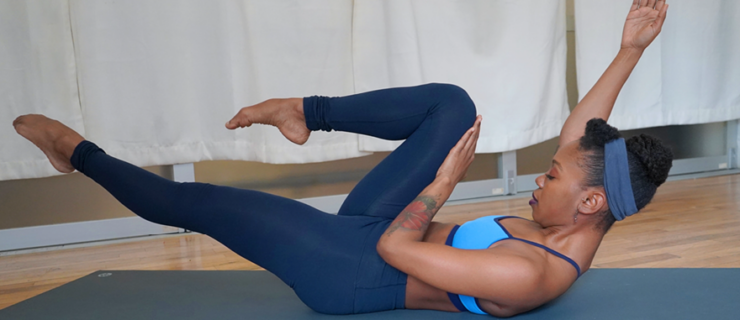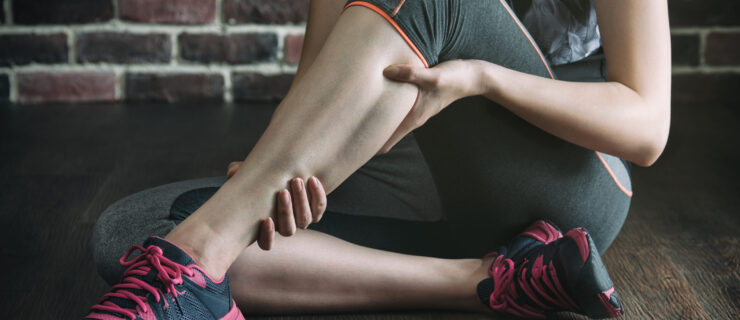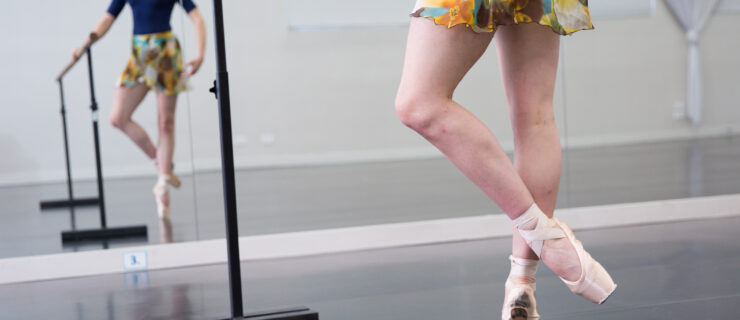Your Best Body: Bad Feet?
It’s a ballet dancer’s eternal question: How do I make my feet better? It seems that our ankles and insteps—no matter how supple they are—are never good enough. But while we all might dream of having arches like Polina Semionova or Paloma Herrera, few of us are born with them.
Jane Rehm, now a dancer with Smuin Ballet in San Francisco, found out early on in her training that her feet were going to be a hurdle. “Pretty much every summer program that rejected me said it was because of my bad feet,” says Rehm. “It was something I knew I was going to have to get past.”
The good news is that with the right strengthening exercises, you can improve the appearance of your feet. And if you start young enough, you can even make them more flexible. But there are limits—and excessive stretching can do more damage than good.
What Are “Bad” Ballet Feet?
Dancers want their ankles to be flexible enough to create at least a straight line from their shin to the top of their foot when pointing. Anything less, and you’ll have trouble getting up on pointe. “Most ankles have about the same total range of motion, but dancers with a flatter foot have more motion toward flexing, and those with a higher arch have more toward pointing,” says Dr. Thomas Novella, a podiatrist based in New York City, who has tested the range of motion in at least 1,500 dancers. “It has to do with the way the rear part of the foot meets the ankle inside the joint.”
While he feels it is possible to improve range of motion through strengthening and moderate stretching, Novella warns that it won’t work for everyone. Dancers in their early to mid-adolescence whose growth plates have just begun to stabilize will see the best results. “Your chance of improving flexibility decreases with age,” he says. Although there isn’t hard statistical data, Novella asserts that by your mid-20s, there’s not much you can do.
How They Can Improve
Kathleen Mitchell, a teacher at Boston Ballet School, has helped students in their teens change the shape of their feet. She recommends using the classic Thera-Band exercises at a slow, controlled pace to increase strength in the ankle and metatarsals. While holding the Thera-Band taut against the ball of your foot, slowly point and flex while fully articulating through the foot. After repeating several times, keep your foot pointed against the band and slowly flex and point the toes only, leaving your ankle in the pointed position.
Stretching properly can also help. “A physiotherapist can stretch your ankle and mid-foot to give the appearance of having more pointe,” says Novella, “but it can take years and there’s no guarantee.” Novella recommends a technique called contract-relax, in which a dancer pushes against a physical therapist’s hand, then relaxes to let the muscles stretch farther than before.
Dangerous Measures
While some perhaps painful efforts, like cramming your toes under a door, may seem like a worthwhile sacrifice, think again. “If something sounds crazy, it probably is,” says Rehm, “and in the long run, it will set you back.” Sleeping in your pointe shoes, standing on the tops of your metatarsals, having a friend sit on your feet or banging your arches to make them swell are dangerous behaviors that can cause serious damage.
“That’s not active stretching,” says Mitchell. “It would be like just slamming down into the splits.” Dr. Novella points out that dancers often cause Achilles tendonitis by overstretching. “You’re inducing mobility in joints that really should be stable,” says Novella. “If you’re going to stretch the arch and ankle, you need to make sure that the strength of the muscle groups around the joints is maintained.”
And resist the temptation to cover up bad feet. “You want to know exactly what you’re dealing with so you can see your progress,” says Rehm. “Don’t constantly wear legwarmers over your feet—look at them and let people help you.”
Roadblocks
In some cases, the issue isn’t as simple as an inflexible arch. Dancers who feel pain in the back of their ankle may have an extra bone called the os trigonum. “It’s like having a little marble between the leg bone and the ankle that blocks the foot from pointing,” says Novella. While the os trigonum can be surgically removed, Novella warns that recovery time can range between seven weeks and seven months, and still may not produce a pointe comparable to if the bone had never been there.
Tight upper thighs can also create an obstacle to getting up over your pointe shoes. “If dancers are back in their hips because their hip flexors or quads are tight,” Mitchell warns, “then the ankle joint has to do all of the work.” Stretch out your hips and quads often and make sure to use your glutes when rising onto pointe.
Work With What You’ve Got
Luckily, many professional ballet dancers have found success even though they won’t be modeling pointe shoes any time soon. “What’s gotten me where I am is how I work, my focus and my ability to pick things up quickly. My feet aren’t terrible anymore, but I still have to work on them all the time,” says Rehm, who strengthens her feet through daily exercises, such as tracing the letters of the alphabet with her toes. “And you have to find your angle—sometimes things need to shift a bit to make the line better.”
Rehm finds that the type of pointe shoes she wears, as well as how she prepares her shoes, makes a huge difference. “If you don’t have a very flexible foot, you don’t need much of a shoe in terms of hardness,” says Dierdre Miles Burger, director of Orlando Ballet School. Go for a more pliable, flexible shoe. Mitchell also advises dancers to “three-quarter” the shanks of their pointe shoes, or cut the shank where their arch naturally bends.
The best thing you can do to improve the appearance of your feet is use them properly. “You have to maximize your rotation and presentation,” says Mitchell. By articulating through the floor and creating a beautiful line, the focus can be drawn away from the foot and more to the presentation of the legs. In the end, using what you have well will serve you best. “Strong, articulate feet, no matter how they’re shaped,” says Burger, “is what’s most important.”
Kathleen McGuire writes about dance from Pittsburgh, PA.
Skip The Morning Muffin
A sweet tooth can be the Achilles heel of an otherwise healthy diet. Keep yours in check by steering clear of sugary treats in the morning. “If you first eat sweets in the morning, your taste buds ‘like the idea’ and your brain responds, telling your body to keep the insulin up,” explains Peggy Swistak, nutrition consultant for Pacific Northwest Ballet. You’ll keep craving more throughout the day to keep your sugar high going. Break the cycle by eating protein or a high-fiber/protein combo. Snack on some whole grain bread, crackers or cereal with peanut butter, a little cheese, yogurt or low fat milk.
Merde!
Backstage rituals might be more than just silly superstitions. According to a study published in Psychological Science, people who carry a good luck charm or perform an act they believe brings them luck (such as keeping their fingers crossed or wishing each other “merde”) do better on tests of memory and agility. Researchers believe they get a performance boost from feeling more confident. So keep the lucky legwarmers—but just be sure to ditch them before you go onstage!
Fire Up The Grill
When Memorial Day arrives on May 30, grill season officially kicks off. And that means it’s time for a nice, juicy steak. Contrary to popular belief, dancers don’t need to shy away from red meat. Although it is generally higher in calories and fat than chicken or fish, if you look at it calorie for calorie steak has one of the highest concentrations of nutrients of any protein. Simply choose your cuts wisely and you can avoid beefing up.
Benefits: Beef is the number one food source for protein, zinc and vitamin B12. It’s also loaded with iron, niacin and vitamin B6.
Selection: Choose cuts that are at least 95 percent lean—look for the words “round,” “loin” or “roast” in the name. “Choice” and “select” cuts are better options than “prime.” Grass-fed beef is also leaner and has fewer hormones.
Portion Size: One serving is about the size of an iPhone.
Easiest Way to Cook: Salt and pepper it, then throw it on the grill.
The Soreness Diet
Most dancers live in a state of almost constant soreness. They stretch and use self-massage to work out the kinks, but too many overlook their diet, which can be the secret to a speedy recovery. The next time your body’s aching, add these three foods to your meal plan.
1. Salmon. This fish is rich in omega-3 fatty acids, which help to reduce inflammation in your muscles. Opt for wild varieties to get the most omega-3s.
2. Ginger. A recent study showed this herb can ease soreness by up to 25 percent the day after your workout.
3. Blueberries. Grab a handful for a healthy serving of polyphenols, an antioxidant that may help fight off the muscle tissue damage caused by exercise.
Do Energy Shots Work?
Promising hours of energy, no “crash” and few calories, products like 5-Hour ENERGY and Red Bull Energy Shots seem like a dancer’s dream come true. But do they actually work? Unfortunately, not really. “The energy sensation you get is a pharmacological central nervous system stimulation from the caffeine, which is not the same type of energy that you would get from eating real food—which is usually the kind dancers need,” says Ashley Doyle-Lucas, PhD, a nutrition specialist and former dancer. “The overall effect is fairly temporary and could lead to light-headedness, heart palpitations and decreased performance. The shots also act as a diuretic, a significant danger since dancers are typically a dehydrated group of athletes.” A better option? Grab a yogurt and piece of fruit or half of a whole wheat bagel with turkey—and a large glass of water.
Tip: Stretch Deeper
Want to get a better stretch? Hop on the foam roller first. “Rolling helps to break up adhesions in the muscle,” says Sally Donaubauer, a physical therapist at the Harkness Center for Dance Injuries. “It can also help mobilize the fascia around the muscles.” When the fascia (the connective tissue that surrounds your muscles) is loosened up, you can go further, getting a more productive stretch.
Under Pressure
When you’re recovering from injury, recuperating body parts can swell, particularly as the day wears on. When you first start going back to class, consider wearing compression tights. “These tights don’t allow the tissue to expand, so blood doesn’t pool in your legs and feet. It circulates back to the heart instead,” explains Steve McCauley, an athletic trainer who works with dancers in Las Vegas. The thick leggings incorporate tight bands of fabric that hug the legs and keep your blood moving. However, they can be a bit restrictive, so they’re not something you’d want to wear on a routine basis.
“Compression tights can give you more awareness of the legs and minimize the swelling that occurs during the active phases of rehab,” says Michael Leslie, the company physical therapist at San Francisco Ballet. He says SFB dancers use them often during recovery. Check out varieties from Capezio and Danskin.






